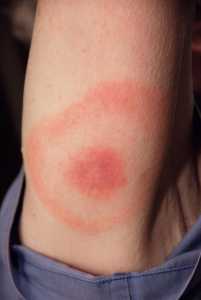27 Nov CDC Study Finds Lyme Disease Remains a Public Health Challenge
MedicalResearch.com Interview with:

This 2007 photograph depicts the pathognomonic erythematous rash in the pattern of a “bull’s-eye”, which manifested at the site of a tick bite on this Maryland woman’s posterior right upper arm, who’d subsequently contracted Lyme disease.
Lyme disease patients who are diagnosed early, and receive proper antibiotic treatment, usually recover rapidly and completely. A key component of early diagnosis is recognition of the characteristic Lyme disease rash called erythema migrans. This rash often manifests itself in a “bull’s-eye” appearance, and is observed in about 80% of Lyme disease patients.
Lyme disease is caused by the bacterium Borrelia burgdorferi, and is transmitted to humans by the bite of infected blacklegged ticks. Typical symptoms include fever, headache, fatigue, and as illustrated here, the characteristic skin rash called erythema migrans. If left untreated, infection can spread to joints, the heart, and the nervous system. From CDC image library
Kiersten Kugeler, PhD
Division of Vector-Borne Diseases
CDC
MedicalResearch.com: What is the background for this study? What are the main findings?
Response: Lyme disease has been a nationally notifiable disease in the United States since 1991. Each year, possible cases of Lyme disease are investigated and tallied by state and local public health officials according to criteria set by the surveillance case definition. States voluntarily share human case data with CDC, which summarizes the data to provide a national perspective on disease trends.
This report summarizes national Lyme disease data reported during 2008-2015. Lyme disease continues to be the most commonly reported vector-borne disease in the United States with more than 275,000 cases of Lyme disease reported to CDC during the study period. Although most cases continue to be reported from states with high incidence in the Northeast, mid-Atlantic, and upper Midwest regions, case counts in most of these states have remained stable or decreased during this time. In contrast, case counts have increased in states that neighbor those with high incidence. The trend of stable to decreasing case counts in many states with high incidence may be due to multiple factors, including the possibility that occurrence of the disease has stabilized in these areas or that some state health agencies have changed their reporting practices to lower the resource burden associated with Lyme disease surveillance. Lyme disease surveillance is not meant to document every case, but rather to indicate disease trends over time, define high-risk groups, and describe the geographic distribution of the condition.
MedicalResearch.com: What should readers take away from your report?
Response: This report highlights the continuing public health challenge of Lyme disease in states with high incidence and demonstrates its spread into neighboring states that previously experienced little Lyme disease. Educational efforts should be directed to these emerging areas to facilitate prevention, early diagnosis, and appropriate treatment.
MedicalResearch.com: What recommendations do you have for future research as a result of this study?
Response: Lyme disease is an ongoing and growing public health problem.
New, effective, and acceptable interventions are urgently needed. In areas where Lyme disease incidence has remained high for years, expensive, ongoing surveillance for human cases is not providing new information that might affect public health intervention. It potentially diverts limited public health resources that might be spent on prevention.
These points suggest the need for a paradigm shift in states with high incidence that would minimize personnel and resource costs while still maintaining awareness of the disease. In contrast, public health surveillance in states where Lyme disease is emerging can serve to increase knowledge of local disease incidence and spread, which could be used to target educational measures for health care providers and the public.
MedicalResearch.com: Is there anything else you would like to add?
Response: This report highlights the continuing public health challenge of Lyme disease in states with high incidence and demonstrates its spread into neighboring states that previously experienced little Lyme disease. CDC is committed to supporting educational efforts directed to these emerging areas to facilitate prevention, early diagnosis, and appropriate treatment.
MedicalResearch.com: Thank you for your contribution to the MedicalResearch.com community.
Citation:
Schwartz AM, Hinckley AF, Mead PS, Hook SA, Kugeler KJ. Surveillance for Lyme Disease — United States, 2008–2015. MMWR Surveill Summ 2017;66(No. SS-22):1–12. DOI: http://dx.doi.org/10.15585/mmwr.ss6622a1.
https://www.cdc.gov/mmwr/volumes/66/ss/ss6622a1.htm#suggestedcitation
Note: Content is Not intended as medical advice. Please consult your health care provider regarding your specific medical condition and questions.
[wysija_form id=”1″]
Last Updated on November 27, 2017 by Marie Benz MD FAAD
